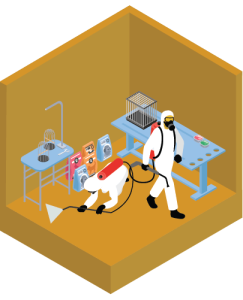Cleaning and disinfection are considered the main methods of preventing infectious diseases in veterinary settings. It is essential to adopt a comprehensive and frequent cleaning and disinfection program, aiming to reduce and maintain a low concentration of pathogenic microorganisms in the environment, thus hindering the likelihood of infections.


THE DEATHCLEAN® presents a certified and effective solution for the prevention of infectious diseases in environments where the presence of animals is constant. We certify our service by using standardized cleaning, disinfection and decontamination techniques for each location and environment to be intervened, using proven disinfectants to eliminate the most common microorganisms that are harmful to animals, as well as humans.
THE IMPORTANCE OF CLEANING AND DISINFECTION


The cleaning and disinfection service must be carried out with the aim of adequately eliminating all microorganisms (fungi, viruses and
bacteria), thus ensuring a safe environment.
Animals treated in veterinary clinics and hospitals, even if they do not present specific symptoms, should be considered as potential transmitters of infections, whether to humans (zoonoses) or to the animals themselves.
BEFORE

AFTER

THE MOST PRONE MICROORGANISMS

Canine parvovirus
It is a highly contagious virus, responsible for parvovirus in dogs (canine parvovirus), which spreads through direct dog-to-dog contact, contact with contaminated feces, environments, surfaces, water, food and objects belonging to animals, as well as the hands and clothes of those who handle infected dogs. It is resistant to various conditions, such as heat, cold and humidity, and can survive in the environment for long periods of time.
Canine parvovirus (CPV)
Klebsiella pneumoniae
It is a pathogen responsible for various types of nosocomial infections and is considered a multidrug-resistant microorganism. This bacteria can be transmitted through direct contact with saliva and other secretions from the infected animal or through contact with contaminated objects. It is a bacteria that spreads easily through skin contact or through the air and any animal or person can be infected.
Klebsiella pneumoniae (KPC)
Feline calicivirus
Calicivirus is highly contagious and affects cats, which can transmit the virus through saliva or secretions from the nose or eyes. The virus can survive in an environmental reservoir for up to a week (and possibly longer in a cool, moist place). Cats can contract this virus through direct contact with another infected cat or through environmental exposure to objects that have been contaminated with infectious secretions.
Feline Calicivirus (FCV)
Microsporum canis
It is the most common fungus that affects both dogs and cats, and is the dermatophyte that causes the infection known as dermatophytosis, also known as ringworm or tinea. It invades keratinized tissues (skin, hair and nails) of humans and animals, causing infection, an important zoonosis (animal diseases that can be transmitted to humans). These organisms can be present in animals, in the environment, as well as in their objects.
Microsporum canis
Feline Coronavirus
Feline Infectious Peritonitis, known as FIP, is one of the most important fatal diseases in cats, caused by the Feline Coronavirus, which is actually a mutation of the Feline Enteric Coronavirus (FECV). This Coronavirus is transmitted by direct or indirect contact, through secretions from the respiratory tract, contact with feces, urine or contaminated objects. It is a virus that can survive up to 7 weeks.
Feline coronavirus (FCoV)
Canine Adenovirus
It causes the disease Canine Adenovirus, which is responsible for a series of uncomfortable problems in dogs, such as severe respiratory problems, among others, as it is a virus that triggers diseases such as Canine Infectious Hepatitis (ICH), as well as Canine Flu (Kennel Cough). This virus is transmitted through contact with environments and objects that have been used by an infected animal and through aerosols.
Canine adenovirus
DEATHCLEAN INTERVENTION

We offer an excellent service, performed exclusively by qualified professionals:

CLEANING AND DISINFECTION
We carry out disinfection with high-level products, suitable for combating all multi-resistant microorganisms.

QUALIFIED TEAMS
Service carried out by multidisciplinary teams duly qualified to intervene in high-risk locations.

TESTING AND ANALYSIS
Confirmation of cleaning and disinfection carried out using microbiological tests and analyses.

CERTIFICATION
Delivery of a legally valid disinfection certificate, certifying that the site is free from biological contamination.
PLACES WHERE WE CAN INTERVENE

See the DEATHCLEAN® and have a certified and quality service for your space:

VETERINARY HOSPITALS
These are places that require regular and planned intervention, using disinfection protocols.

VETERINARY CLINICS
These are clinical spaces prone to the regular emergence of infectious and zoonotic diseases.

KENNELS, HOTELS AND SHELTERS
Measures and procedures must be adopted to eliminate all risk factors that cause outbreaks.

QUALIFICATIONS
Despite being a more controlled environment, zoonoses can also arise in private homes.
OUR WORK

Related Services

VETERINARY DISINFECTION
Cleaning and disinfection are considered the main methods of preventing infectious diseases in veterinary settings. It is essential to adopt a comprehensive and frequent cleaning and disinfection program, aiming to reduce and maintain a low concentration of pathogenic microorganisms in the environment, thus hindering the likelihood of infections.
THE DEATHCLEAN® presents a certified and effective solution for the prevention of infectious diseases in environments where the presence of animals is constant. We certify our service by using standardized cleaning, disinfection and decontamination techniques for each location and environment to be intervened, using proven disinfectants to eliminate the most common microorganisms that are harmful to animals, as well as humans.
We also perform this service in urgent situations, resolving all cases of outbreaks that may occur in clinics, kennels, dog boarding facilities or other locations, including private homes, that require specialized and certified intervention to combat the spread of zoonotic (zoonoses) and infectious diseases in these environments.

THE IMPORTANCE OF CLEANING AND DISINFECTION

The cleaning and disinfection service must be carried out with the aim of adequately eliminating all microorganisms, thus ensuring a safe environment.
Animals treated in veterinary clinics and hospitals, even if they do not present specific symptoms, should be considered as potential transmitters of infections, both to humans (zoonoses) and to the animals themselves. Therefore, spaces that provide health care to animals should be considered as having a potential risk of cross-contamination.
In order to prevent this from happening, these areas must be cleaned and disinfected regularly. The basic principles of cleaning and disinfection are the same in clinics or hospitals where animals are cared for as in hospitals where human care is provided. However, due to the specific characteristics of veterinary clinics and hospitals, these processes are not properly standardized and evaluated, although there is a risk of cross-contamination and infection in these areas.
Understand that regularly cleaning and disinfecting the veterinary space will bring benefits to your business, namely in terms of customer confidence, since a customer's intention is to have a healthy animal and not to frequent a space where their animal, instead of being treated and cured, is subject to catching other infectious diseases, some of which can lead to the animal's death. The aim is to reduce the possibility of infections occurring in animals, taking greater care of their lives and also to avoid complaints and unnecessary expenses, such as a complaint and the possible closure of the business.
See the DEATHCLEAN® to obtain the service you need, whether it is regular or one-off.
We can help you find the most suitable cleaning and disinfection solutions, hiring the only certified and specialized company in Portugal, with essential qualifications to guarantee a legally certified service.
BEFORE

AFTER

WHAT ARE THE MOST PRONE MICROORGANISMS?
Canine parvovirus
It is a highly contagious virus, responsible for parvovirus in dogs (canine parvovirus), which spreads through direct dog-to-dog contact, contact with contaminated feces, environments, surfaces, water, food and objects belonging to animals, as well as the hands and clothes of those who handle infected dogs. It is resistant to various conditions, such as heat, cold and humidity, and can survive in the environment for long periods of time.
Canine parvovirus (CPV)
Klebsiella pneumoniae
It is a pathogen responsible for various types of nosocomial infections and is considered a multidrug-resistant microorganism. This bacteria can be transmitted through direct contact with saliva and other secretions from the infected animal or through contact with contaminated objects. It is a bacteria that spreads easily through skin contact or through the air and any animal or person can be infected.
Klebsiella pneumoniae (KPC)
Feline calicivirus
Calicivirus is highly contagious and affects cats, which can transmit the virus through saliva or secretions from the nose or eyes. The virus can survive in an environmental reservoir for up to a week (and possibly longer in a cool, moist place). Cats can contract this virus through direct contact with another infected cat or through environmental exposure to objects that have been contaminated with infectious secretions.
Feline Calicivirus (FCV)
Microsporum canis
It is the most common fungus that affects both dogs and cats, and is the dermatophyte that causes the infection known as dermatophytosis, also known as ringworm or tinea. It invades keratinized tissues (skin, hair and nails) of humans and animals, causing infection, an important zoonosis (animal diseases that can be transmitted to humans). These organisms can be present in animals, in the environment, as well as in their objects.
Microsporum canis
Feline Coronavirus
Feline Infectious Peritonitis, known as FIP, is one of the most important fatal diseases in cats, caused by the Feline Coronavirus, which is actually a mutation of the Feline Enteric Coronavirus (FECV). This Coronavirus is transmitted by direct or indirect contact, through secretions from the respiratory tract, contact with feces, urine or contaminated objects. It is a virus that can survive up to 7 weeks.
Feline coronavirus (FCoV)
Canine Adenovirus
It causes the disease Canine Adenovirus, which is responsible for a series of uncomfortable problems in dogs, such as severe respiratory problems, among others, as it is a virus that triggers diseases such as Canine Infectious Hepatitis (ICH), as well as Canine Flu (Kennel Cough). This virus is transmitted through contact with environments and objects that have been used by an infected animal and through aerosols.
Canine adenovirus
DEATHCLEAN INTERVENTION
We offer an excellent service, performed exclusively by qualified professionals:

CLEANING AND DISINFECTION
We carry out disinfection with high-level products, suitable for combating all multi-resistant microorganisms.

Qualified Teams
Service carried out by multidisciplinary teams duly qualified to intervene in high-risk locations.

TESTING AND ANALYSIS
Confirmation of cleaning and disinfection carried out using microbiological tests and analyses.

Certification
Delivery of a legally valid disinfection certificate, certifying that the site is free from biological contamination.
PLACES WHERE WE CAN INTERVENE
Consult DEATHCLEAN® and have a certified and quality service for your space:

Veterinary Hospitals
These are places that require regular and planned intervention, using disinfection protocols.

Veterinary Clinics
These are clinical spaces prone to the regular emergence of infectious and zoonotic diseases.

Kennels, Hotels and Shelters
Measures and procedures must be adopted to eliminate all risk factors that cause outbreaks.

Housing
Despite being a more controlled environment, zoonoses can also arise in private homes.
our work
Related Services

















